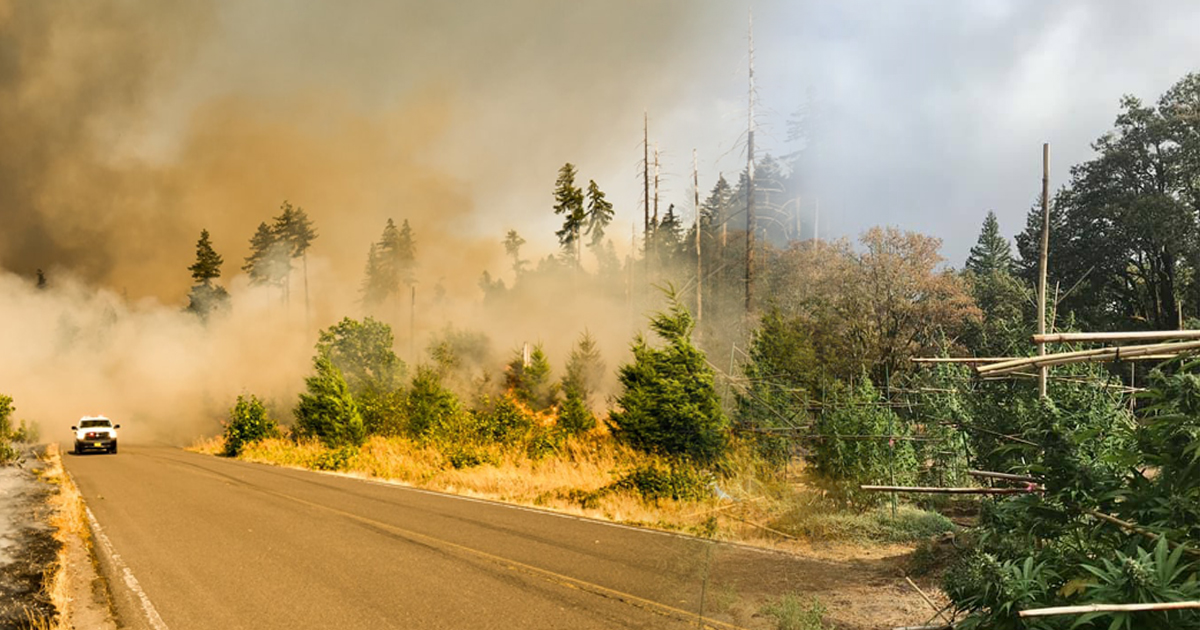The changing of the seasons has typically marked the culmination of the annual outdoor cannabis crop in a time of year many farmers refer to as ‘Croptober’.
Though the hard work is far from complete to get the harvest to market, sungrown weed farmers can typically at least take a deep breath and give thanks for the completion of their crop before the arrival of fall and the climate-related challenges that come with it.
Now there is a new season, however, Fire Season, and although California has endured this threat for years now, it is clearly getting worse and it is not just contained to Cali anymore.
Wildfires have threatened outdoor cannabis crops in California before, most notably in the state’s infamous Emerald Triangle region where thousands of weed farms – permitted or otherwise – call home. Not only are they at risk of literally burning down, but even long term exposure to residual smoke and falling ash can have detrimental effects on a crop, especially in the late flowering stage as the plant finalizes flavors, aromas, and effects.
Unfortunately, this has recently been the reality year after year, with the threat growing larger each time leading to 2020, the most fucked up year of them all, and the August Complex Fire in NorCal which has now destroyed over ONE MILLION ACRES earning it the dubious designation of ‘gigafire‘, by far the largest ever recorded in California.
With weeks left in the so-called Fire Season, California has seen over four million acres consumed by over 8,200 different fires leading to dangerous air quality levels even dozens or hundreds of miles away from the flames.
Meanwhile, outdoor cannabis farmers in Oregon and Washington who usually only see such devastation on the news and who have their own unique challenges to face each year to ensure a successful harvest were suddenly faced with the frightening calamity and sense of helplessness that comes with wildfires as both states were suddenly inundated with major blazes throughout September and into Croptober.
In mid-September it was estimated that approximately 20% of Oregon’s cannabis farms were evacuated due to the fires raging across the state and that at least seven farms had succumbed to the flames. The sad reality is that the number was and is likely higher, as Oregon still has countless crops grown under the radar, many of which must have been affected by fires.
It is also important to remember that although they do not operate on the same annual harvest cycle as their sungrown colleagues, greenhouse growers and indoor cultivators also get affected by wildfires which can leave a state-of-the-art facility without power or water for days or weeks, potentially losing weeks of work, killing a crop, and placing more strain on the supply chain.
For those farmers fortunate enough to have an operation still standing once the smoke has settled, new challenges arise, especially for the outdoor farmer whose plants have likely been starved of sunlight and blanketed in ash.
Wood ash and water mix to create a paste-like substance that is generally not beneficial for plants, so a simple rinse is not advised and is rarely adequate. Some farmers will use leafblowers to dislodge the majority of the ash from the plants but sticky buds can be stubborn and there is still the soil to consider once that ash lands wherever it lands. Soil amendments at such a late stage are not ideal, and may even be taboo to some appellation-based operations.

The severity of the fires in California this year along with the outbursts in Oregon and Washington have been devastating, for sure, but one silver lining on the orange skies has been the coming together of the cannabis community to both help those in need and to come up with affordable, logical, and effective solutions to save Croptober for as many farmers (and smokers!) as possible.
Several cultivators and testing labs have already arranged to perform some unprecedented R&D testing to determine the effectiveness of various remediation methods that are being applied to plants most heavily affected by the fires. Yes, unfortunately a lot of outdoor bud will be lost this year, but clever cannabis farmers are already drawing up the playbook to hopefully help others avoid those losses next time around.
CAN WE END THIS YEAR ALREADY?
2020 has for the most part been a year to forget, as soon as possible. It has, however, revealed many of the core needs that our society has that have been ignored for far too long by our federal government. For instance, without getting too political, it seems ridiculous to us that we even have to debate the right for affordable healthcare for all Americans while we still trudge through a global pandemic that has killed over 200k of our fellow Americans just since spring.
Similarly, the fact that the feds cannot get on board with the most sensible cannabis reform efforts that would do nothing more than give basic banking rights and insurance access to tax-paying, state-sanctioned cannabis businesses is simply unacceptable.
 If a liquor store or a pain pill factory or, ironically, a church gets leveled by an “act of God”, they are reimbursed.
If a liquor store or a pain pill factory or, ironically, a church gets leveled by an “act of God”, they are reimbursed.
If a licensed cannabis farm loses its only crop for the year due to that same act by that same “God”, too fuckin’ bad.
So far, this negligence from the top down has primarily only hurt families of farmers on the west coast, but with cannabis legalization spreading like… well… you know… across the country, Croptober is catching on from coast to coast, and people’s livelihoods, not to mention billions of dollars of potential tax revenue, hinges on those harvests.
Trying to bring an outdoor cannabis crop to fruition in markets like Oklahoma or Nevada or, eventually, even Kentucky or Arizona will present its own list of challenges but a dereliction of duty from Uncle Sam should not be one of them.
At this point, we’re not even sure if we want the federal government to “legalize weed” if they are going to do it like they “legalized” “hemp”… we just want them to get the hell out of the way.
As we wrote last year in an article well worth re-reading today, for many of the same reasons we can expect to see cannabis prices remain high for the foreseeable future, in whatever market you shop in.
Our hearts weigh heavy for all of those, whether in the cannabis community or not, who have been affected by these fires.
- Ohio’s Senate Bill 56 Postponed, Leaving Details of Issue 2 Still Unresolved
- Sports Stars and Well Known Entertainers Join Forces Calling on Trump for Cannabis Reform
- Pinsky and the Brain: Bill White on His Journey to Consulting in Cannabis
- Delaware’s Recreational Cannabis Market Finally Set to Launch After Years of Challenges
- Excise Tax Increase to 19% and Its Impact on California Retailers
- Nebraska’s Governor Approves Emergency Medical Cannabis Regulations













